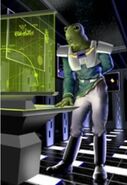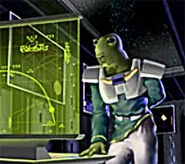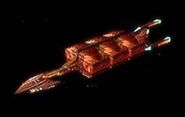Starfleet Command II: Empires at War is a video game, a sequel to the ST video game: Starfleet Command.
Summary[]
Empires at War featured 3 campaign options: 2 story campaigns and a general conquest campaign.
ISC War of Pacification[]
In the aftermath of the events of Starfleet Command's story campaigns (resulting from the disappearance of the Organians), the galactic powers have been in a constant state of war. It is at this point that the Organians return to known space, bringing with them a "galactic superpower", the Interstellar Concordium, to enforce on the other races, as the Organians have become tired of trying to police things. The seven galactic powers resist this forced peace, and a new war ensues.
As the story progresses, it is revealed that the ISC is committing various misdeeds (such as working with the Orion pirates to manufacture the Venus drug and subjecting captured citizens of the other galactic powers to forced re-education) that the Organians would never tolerate from the other galactic powers. However, when these facts are brought to the Organians, the Organians reveal that they are well aware of what is happening, but will not elaborate on why they are allowing it.
Eventually, the other galactic powers enter into an alliance to repel the ISC invasion, beginning with the liberation of three ISC stations that are serving as re-education camps. When the main ISC base is destroyed, the war is essentially over. However, the galactic powers decide that the Organians must stand trial for their involvement in bringing the ISC to known space. After one final battle, the Organians agree to stand trial. It is revealed that the Organians went to the Andromeda Galaxy during the events of Starfleet Command, and that bringing the ISC in to enforce peace was a ploy to teach everyone, including the ISC, how to unite against a common foe; a foe that is revealed to be the Andromedans.
Mirak campaign[]
The second story campaign, playable only by the Mirak, Lyrans, Hydrans, and Klingons (and having no relation to the War of Pacification), focuses on the discovery of artifacts belonging to an ancient race of telepaths. When it is revealed that these artifacts could alter the balance of power in the galaxy, discovering them takes on even more importance. After encounters with cults intent on using the artifacts to inflict pain on everyone in known space, as well as space monsters that are hundreds of millennia old, the homeworld of the telepaths is discovered, and a plan to capture an enemy admiral and force him to do the bidding of the players faction is devised. The campaign ends with the enemy vanquished and the player's faction victorious.
References[]
Appendices[]
Related media[]
- ST video game: Starfleet Command (series sequel)
- Orion Pirates (SFC2 expansion)
Background[]
Differences from SFC1[]
While SFC2 used the same combat engine as SFC1, the multiplayer aspect was completely overhauled for the new "dynaverse". Dynaverse was an attempt to do large scale multiplayer, similar in some ways to an MMORPG. Players of the same faction could team up for missions, and the overall goal was to be the last faction standing.
- Formations can now be set from the fleet control panel.
- The fleet control scheme was redesigned, and certain orders (such as telling a ship to go a location on the map and hold position, or to attack cautiously instead of going in guns blazing) could no longer be issued.
- Capturing a vessel in a single player campaign or skirmish mission now resulted in a ship being added to a player's fleet (most of the time) for the duration of that mission (in the first game, a captured ship would simply attempt to disengage from the mission area).
- The ability to recruit officers was eliminated from the single player campaign. As officers of higher ranks would have a positive effect on ship performance (and lower ranks had a negative effect), this had a noticeable effect on gameplay; for example, having an engineering officer of "veteran" rank resulted in repairs being accomplished quicker than an officer of "senior" rank (considered the baseline rank for effects on ship performance), and a "legendary" officer would improve repair times even further.
- The elite organizations from the first game were eliminated.
- The Gorn freighter and base were redesigned (in the first game, Gorn freighters used the Federation freighter model and skin, while the Gorn base was a re-skin of the existing pirate base model).
- New ship models were added for certain Lyran, Hydran, Gorn, and pirate ship classes.
- 'Base' stations (lower firepower compared to battle stations and starbases) now used a common model between the empires, with the only difference being the emblem on the station, depending on the faction the player chose.
- Single player campaign games no longer ended when the final story mission was completed.
- Unique menu designs for each race were dropped in favor of a single universal design; unique tactical interface designs remained.
- Players could no longer purchase specialized versions of shuttlecraft at spacedock, they had to be converted during a mission, and would affect ship stores (for example, converting a shuttle into a scatterpack shuttle required six missiles from the missile rack stores of a ship, and a suicide shuttle required the use of a mine).
- Asteroid models and skins were pared down from the first game.
- Energy allocation could now be controlled by the player, and divided among propulsion, heavy weapons, shield reinforcement, tractor beams, and electronic warfare (in the first game, if a ship was attempting to use more energy that it was producing, the game would allocate energy automatically, without any player control).
- Bases could be placed on the map by the player.
- Bases could now be controlled by a player in certain mission types. Previously, all bases were computer controlled.
- Two forms of anti-missile defense were added, depending on the race selected. Empires that used missiles (the Federation, Klingons, and Mirak) received a system that worked similar to an anti-aircraft gun, while plasma races (Gorn, Romulans, and the ISC) received a special type of plasma torpedo that functioned in a similar manner.
- Hit-and-run raids could be paused if desired.
- Players could no longer change the map for the 'Hostile Skirmish' skirmish mission.
- Commando (marine) ships were marked as 'special' in the game operating files, and could no longer be purchased in single player campaigns.
- Customization for some skirmish missions was taken to its logical conclusion: on the advanced setup screen, a player could choose which enemy and allied vessels would appear, and how they were equipped with things like missiles, marines, etc.
- Single player campaigns became essentially self-contained multiplayer campaigns, with minor changes to reflect the lack of other human players (such as not needing to bid on a ship).
- The use of the new Dynaverse engine for single player campaigns also meant that if a player failed a mission, or did not complete a mission to their satisfaction, instead of being able to start a mission over from the debriefing screen, a player had to re-load a saved game instead.
- A lighting system was implemented, and players could adjust the amount of ambient light was present on maps. Ship models were given lighting textures to give the illusion of running lights. Damage textures were also added.
- Fighters were added for all races, having been a Hydran specialty in the first game.
Images[]
External link[]
- Starfleet Command II: Empires at War article at Memory Alpha, the wiki for canon Star Trek.
- Starfleet Command II: Empires at War article at Star Fleet Universe wiki, the wiki for Star Fleet Universe / Star Fleet Battles.






